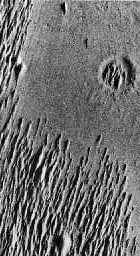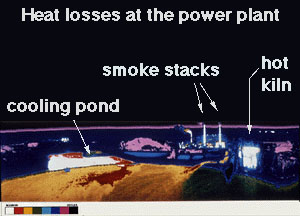Earth


These pictures show craters at different places on the Earth's surface.
The left image shows two
craters in Quebec, Canada (Click on image
for full size version (315K GIF) Courtesy of
NASA/LPI ). The right image shows the
Barringer Meteor Crater in Arizona
(Click on image for full size version (307K GIF),
Courtesy of D. Roddy and LPI ).
Like other planets, the surface of the Earth has many
craters. Barringer Meteor Crater (right image), located in Arizona, is 1.2
km across, and is 49,000 years old. The two impact craters seen
in the left image are the Clearwater East and West craters, located in
Quebec, Canada. They were formed at the same time by
two separate but
probably related meteorite impacts.
These two craters look much more worn away or eroded than the more
recent Barringer crater.
|
Mars


These pictures show craters on the surface of Mars.
The picture at the left shows heavily cratered portion of Mars, and was
obtained by Mariner 6 in 1969.
(Click on image for full size version (282K GIF),
Image courtesy of NASA). The image at the right shows an eroded
crater and dune fields near the south pole of Mars. (Click on image for
full size version (112K JPG),
Image courtesy of NASA).
There are many craters on the surface of Mars. The
image at the
left (best seen at full size), taken by Mariner 6 in 1969, shows many
craters in the Sinus
Sabaus and Deucalionis Regio region of Mars. In the full size picture you
can see craters within craters,
overlapping craters, and craters with raised central peaks. The image
at the right shows a crater and sand dunes near the south pole of Mars.
Craters in this region of Mars are being
erased by the action of sand on the Martian surface. There are even sand
dunes within the crater.
|









